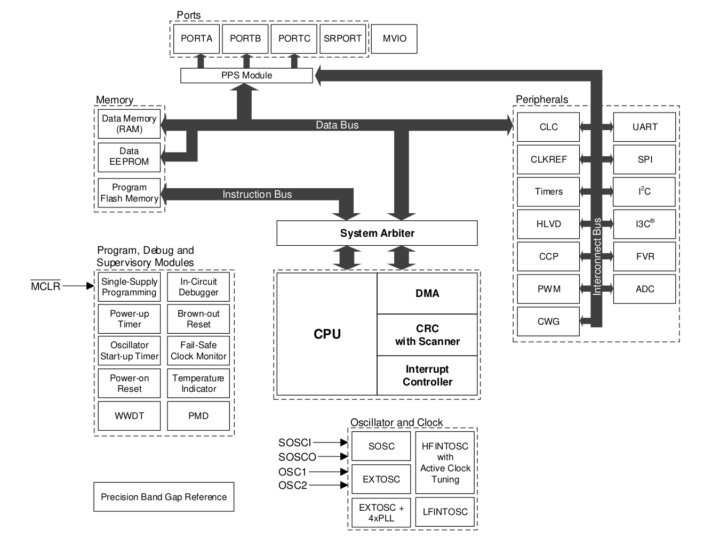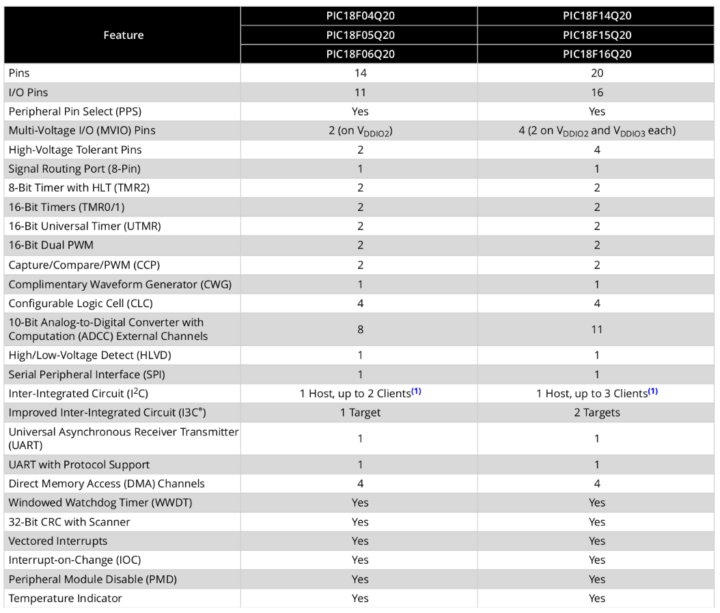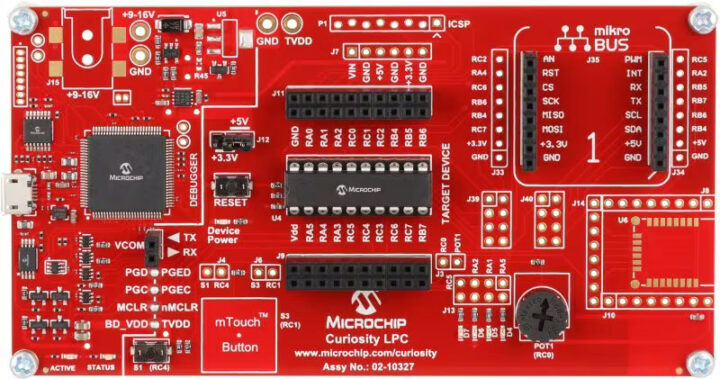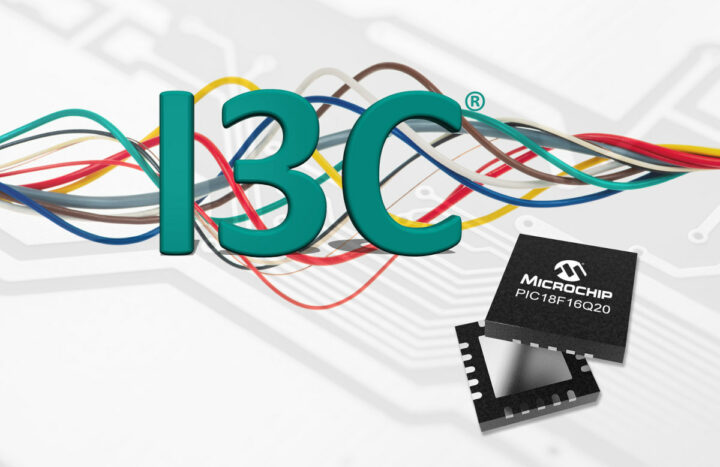Microchip PIC18-Q20 is a new family of microcontrollers (MCUs) with a low-pin count (14 and 20-pin packages) that integrates up to two I3C interfaces as well as multi-voltage I/O (MVIO) interfaces.
MIPI I3C was first teased in 2014, then officially announced in 2017, and the first MIPI I3C specification was released the following year, as a backward compatible update to I2C with lower power consumption, and higher bitrate allowing it to compete against SPI. We’ve seen it used in a few application processors and microcontrollers, but it’s the first time I3C can be found in a lower-cost, low-pin count microcontroller.

Microchip PIC18-Q20 specifications:
- Core – PIC18 8-bit RISC microcontroller core @ 64 MHz
- Memory – 1KB to 4KB RAM
- Storage – 16KB to 64KB with Memory Access Partition (MAP) support, 256B EEPROM
- Peripherals
- Up to 2x I3C device interfaces
- Adhere to MIPI I3C Basic Specification 1.0
- Support Target Reset Action (RSTACT) CCC from MIPI I3C Specification 1.1
- Support Dynamic Address Assignment, Common Command Codes (CCC), Direct and Broadcast addressing
- 4x Multi-Voltage I/O (MVIO) supporting I3C communication down to 1.0V
- 2x UART including one LIN/DMX/DALIDMA compatible
- 1x SPI, 1x I2C compatible with SMBus, PMBus
- 8-bit signal routing port
- 4x Direct Memory Access (DMA) Controllers
- 2x 16-bit dual PWMs providing 6x PWM outputs
- 11-channel 10-bit Analog-to-Digital Converter with Computation (ADCC) up to 300 Kbps
- Timers – 2x 8-bit + 2x 16-bit
- Hardware Capacitive Voltage Divider (CVD) Support
- Vectored Interrupt (VI) capability
- Peripheral Module Disable (PMD) to selectively disable hardware modules to optimize power consumption
- Peripheral Pin Select (PPS) enables pin mapping of digital I/O
- Up to 2x I3C device interfaces
- Debugging features
- In-Circuit Serial Programming (ICSP) via 2x pins
- In-Circuit Debug (ICD) with 3x breakpoints via 2x pins
- Debug Integrated On-Chip
- Supply Voltage – 1.8 to 5.5V
- Low power consumption modes
- Sleep – < 1μA typical @ 3V
- Doze – CPU and peripherals running at different cycle rates (typically CPU is lower)
- Idle – CPU halted while peripherals operate
- Packages
- 14-pin TSSOP, SOIC
- 20-pin PDIP, SSOP, SOIC, VQFB (3×3 mm)
- Temperature Range
- Industrial: -40°C to 85°C
- Extended: -40°C to 125°C
Six SKUs, namely PIC18F04Q20, PIC18F14Q20, PIC18F05Q20, PIC18F15Q20, PIC18F06Q20, and PIC18F16Q20, are available in three different flash/SRAM configurations…
.. and either 14-pin or 20-pin packages with the same features but a different number of I/Os.

The PIC18-Q20 MCU family is supported by Microchip MPLAB X and MPLAB Xpress IDEs and MPLAB Code Configurator (MCC), and the new family can be evaluated using the PIC18F16Q20 Curiosity Nano Evaluation Kit (no public info yet) or the Curiosity development board. The PIC18-Q20 MCUs are designed for real-time control, touch sensing, and “connectivity” applications.

The PIC18F06Q20 and PIC18F16Q20 microcontrollers with 64KB flash and 4KB SRAM are in production now, but other models are listed as “Future Products”. The press release tells readers to contact a Microchip sales representative for more information and purchase the chips and devkit, but you’ll also find pricing information (95 cents and up for 5K orders), and more technical details, for the new chips at the bottom of the product page.
Thanks to TLS for the tip.

Jean-Luc started CNX Software in 2010 as a part-time endeavor, before quitting his job as a software engineering manager, and starting to write daily news, and reviews full time later in 2011.
Support CNX Software! Donate via cryptocurrencies, become a Patron on Patreon, or purchase goods on Amazon or Aliexpress






